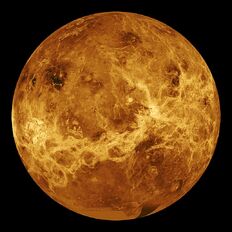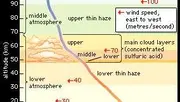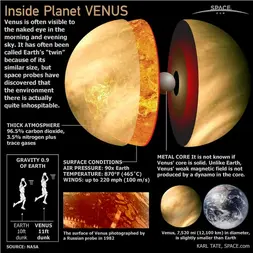Venus is the second planet in our Solar System, and the second largest rocky planet, after Earth. It is only about 600 kilometers smaller than Earth and 18,5% lighter. Being similar to Earth in appearance, mass, size, as well as gravity, which is 8.87 m/s² of Venus compared to 9.81 m/s² of Earth, might suggest equal surface, temperature and atmospheric conditions, but that couldn't be further from the truth.
Venus's atmosphere is so thick and it is full Co2 and Sulfuric acid clouds, that make it up, causing Venus's surface and atmospheric pressure to rise significantly. Because of this, Venus is actually the hottest planet, even hotter than Mercury, which is the closest planet to the Sun. But Mercury has no atmosphere, so it can not trap heat like Venus does.
Observability[]
Venus is usually called the morning star. That's because Venus's atmosphere, apart from being super hot, is also very bright. Venus is by far, the brightest planet in the sky. Early in the morning we can clearly observe it in the night sky with only the naked eye. Venus is the third brightest object than we can see in the night sky, second being the Moon, and first being the Sun.
Venus, being so bright and beautiful, was given it's name by the greeks and romans after the goddess of love and beauty. The goddess was named Aphrodite, which was called Venus for the roman mythology and religion. Venus being so bright was obviously thought to be a star and also the brightest and largest wandering star, as the planets were known as the wandering stars.
Atmosphere[]

False-color image of Venus without atmosphere
The atmosphere of Venus is drastically different from all of its planetary counterparts.
Compared to Earth, Venus' atmosphere consists 96.5% of carbon dioxide and 3.5% of nitrogen. It weighs 93 times more than Earth's.[1]This causes Venus to be highly inhospitable and toxic, as well give Venus acidic rains.[2]Venus's atmosphere is full of carbon dioxide which cause the greenhouse effect to be very powerful. Above the dense Co2 layer, are very thick clouds of sulfuric acid that also heat up the planet. And yes, Venus has acidic rains of sulfur and Co2 that are very toxic and hot too.

The atmosphere of Venus.
This property wasn't always like it is now, as in past, the atmosphere of Venus was similar to Earth, but with the evaporation of its water came the greenhouse effect, which slowly caused Venus to turn into what it is now.[3]With water evaporating, Venus's surface released sulfur and carbon dioxide into Venus's atmosphere, causing this greenhouse effect to occur, heating up the second closest planet to the Sun, making it the hottest planet and also the most toxic planet of all.
Expectadly, this has caused multiple problems and complications during missions, as rovers can survive only a couple hours on Venus. That's why NASA and other space agencies do not allow many robots, vehicles and obviously humans to land on Venus' toxic environment.
Geography[]

Interior and facts about Venus
The surface of Venus has been heavily changed by volcanic activity. Due to the age of Venus' crust, the amount of volcanoes skyrockets, with over a hundred being 100km+ in diameter. This also happened because of Venus's hot atmoshere and temperature, that melt down Venus's surface. Again, causing both the atmopshere and surface of Venus to be toxic and inhospitable.
Any craters located on Venus can only be 3 km or larger, as the atmosphere prohibits anything smaller than 3 - 4 km to crash into it.[4]Well, the entire surface of Venus is hot and molten, almost liquid but on Venus it's beacause of the atmosphere, while on Mercury, it's because it has no atmosphere and meteors hit it. So on Venus, craters exist because of the atmosphere. We have a twist here, something we 've seen on other planets. Venus's atmosphere causes craters, even though on other planets, their atmospheres prevent craters.
Sadly, though, we know very close to little about the internal composition of Venus, we can only hope to gather somewhat correct data by comparing Venus to Earth, due to how similar it is in age and size, and hope that the data extrapulated is correct. Sometimes, we know this data has to be correct, for example, we know that the core of Venus is liquid, because it started to cool down at the same rate and time as Earth. We currently believe that Venus's interior is similar to that of Earth but it's not impossible to doubt this possibility.
References[]
Full page: User blog:A86475342/Venus
